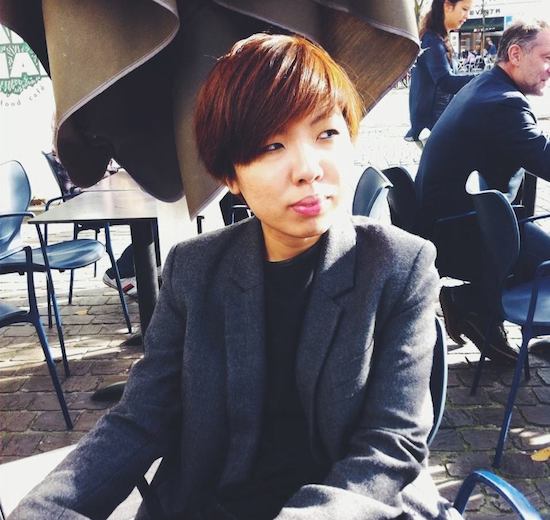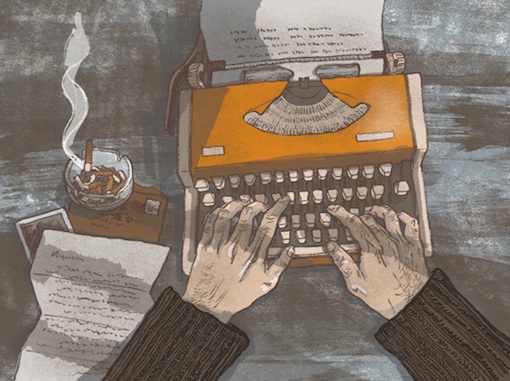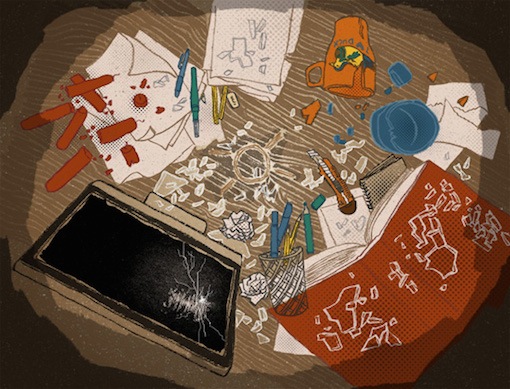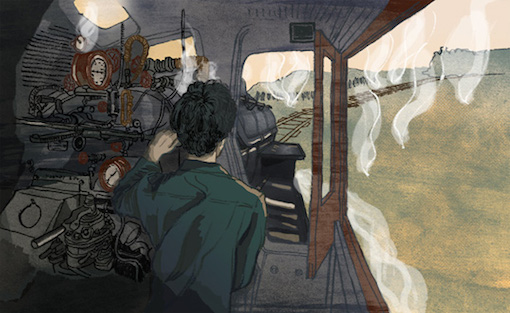Antwerp-based illustrator Shuxian Lee is Asymptote’s guest artist for the January issue. Her joyous, Escher-esque cover image is perfect for our 4th anniversary, while her beautiful, evocative, and often poignant illustrations accompany a total of seventeen texts. I interview her about her process and inspirations, and find out more about her graphic novels.
Berny Tan: I find your illustrations incredibly rich in both texture and colour. Could you take us through your process of conceiving and executing each piece?
Shuxian Lee: I’m quite a visual person—when I read something or feel something, I get these viewpoints in my head that are sometimes quite filmic and are related to a certain mood. Sometimes, when I come across certain expressions, I’m reminded of certain artworks or patterns that inspire me. I love to draw references to paintings because painters (mostly 19th- and 20th-century ones) are some of my biggest inspirations and first loves!
Once I get this image in my head, then I’ll sketch thumbnails of some of the ideas—though to be honest, I’m quite lazy about this part because I usually already have the finished composition in my head. Next, I look for reference images for colour, gesture or to get the perspectives right, then I start sketching. I usually make my own reference images too, and I rely a lot on my partner (or myself) as a model for my characters.
If the sketch works, I get started with the inking, then I scan it and colour it in Photoshop. I love organic textures of paint and dirt and brush marks, so I try to integrate that during the digital colouring too. In general, I work with non-digital mediums, but it’s nice to discover ways to replicate the non-digital look on Photoshop. I actually only started using Photoshop to colour a few years ago, so I’m still figuring out lots of things.
In your illustrations, you’ve masterfully captured moments in each text with great depth and detail. What are the challenges of representing a narrative in one static image, and how do you overcome them?
I think my biggest worry is that I don’t illustrate the “right” moment. Some of the stories have very strong visual imagery that immediately stand out, like a motif that represents the theme, mood, or intention of the piece. However, there are others that involve several strands, making it difficult to choose the “right” motif. Nevertheless, I do realise that my illustrations serve as an accompaniment, and that they ultimately show my own perspective of the story. I hope I managed to do that without discrediting the actual piece!
At the end of the day, I try to think about my illustrations as that initial visual impact when a reader encounters a piece of writing. In a way, I try to make it easy for people to deduce what the story could be about just by looking at the illustration first; for example, a war piece will have some blood spatter, or a piece set in a particular place will have obvious trademarks of that place. Or, I try to create some sort of metaphor by placing various symbolic objects together.
You have created a number of graphic novels in addition to your standalone illustrations. Which medium do you prefer and why?
Graphic novels, definitely! I really love watching films and reading, and I see graphic novels as a perfect combination between the visual and the text. It’s my favourite method of expression or telling stories. I like to talk a lot, even to the point of narrating whatever is happening around me in my head, so I can’t stick to just a standalone illustration. They can be very powerful of course, maybe as an introduction to a theme, but graphic novels are like the entire symphony and I love telling stories. They allow you a lot of space for experimentation, both visually and textually.
Your graphic novels are intensely personal, and I sense that this intimacy permeates your illustrations as well, even though they depict narratives that are not your own. Why is this quality important to you?
Actually, I find myself struggling with this “narcissistic aspect” of my work. (Though of course, who doesn’t face this issue, at the end of the day?) I’ve received feedback that sometimes this could be an obstacle to attracting more audience for my work, and I fully agree with that. But an acquaintance once told me that since I’m human and also part of the human experience, my personal stories are not necessarily narcissistic. Rather, it’s a contribution of one voice to the whole range of human voices. I do believe in at least making work about what I have felt or experienced or strongly believe in. Only then do I feel the urge to make art at all.
Who are the artists that you most admire?
I love the Impressionists and Post-Impressionists, especially Degas and Toulouse-Lautrec. As for contemporary artists, I’m most bowled over by James Jean in terms of technique. Recently, for my thesis, I did more research on artists like Sophie Calle, Marina Abramović, and Tracey Emin, and they became my lovers for that moment. I admire them greatly for the stories they tell—very feminine stories, with great strength and power. In fact, I made two mini-comics in which I talk to Emin and Abramović about my project, and their experiences with love, art, and longing.
I really admire the graphic novelist Craig Thompson, mostly because of the kinds of stories he tells. I’ve realised that I’m at a point where I admire artists not solely based on their technical abilities, but more based on their personalities, or what I assume they’re like through their work. Jeffrey Brown belongs in this category too—he makes the most sincere, heart-rending comics, and I wish I knew him in person.
Among the seventeen texts that you illustrated for us, which text did you most enjoy reading, and which text did you most enjoy illustrating?
I have an inclination for fiction, and therefore I enjoyed reading most of the fiction and drama works. They’re all so different; I can’t pick a favourite. In general, I enjoy drawing human figures, so I most enjoyed illustrating the ones that had some kind of organic element (a hand, a person).
What other projects do you have planned for the near future?
I’m working on a new graphic novel story, which involves three female voices, set in a somewhat controversial context revolving around domestic abuse and rape. There is also some background reference to Gaza and the political environment in Turkey. It’s still quite close to what I do, in that I’d choose to focus on the inner stories—the more “domestic” area, so to speak. I believe these viewpoints are very relevant and should be heard more, especially in graphic novels, which tend to have more dominant male voices. I’m already done writing the script, and now I’m in the process of thumbnailing it.
***
Shuxian Lee, is an illustrator from Singapore, currently living in Belgium. Her background in filmmaking and graphic design has pushed her love for the graphic novel medium. She weaves stories of loss and longing and meditations on the mundane that sometime border on the surreal, with undercurrents of dark humour. Her graphic novels have been published in Afterglobe, Liquid City 3, Boktor Magazine, and C’est Bon Anthology. She has also exhibited in Singapore and Brussels. Her website can be found here.
Berny Tan is Asymptote’s Chief Executive Assistant. She was born and raised in Singapore, and graduated with a B.F.A. in Visual & Critical Studies from the School of Visual Arts in New York (2014). She is navigating her potential roles as artist, writer, designer, and curator, and has worked at art institutions in both New York and Singapore. Her artwork explores the interweaving of the systematic visual language of diagrams with a deep, emotional introspection, and her writing has been published in Ceriph. She is one half of the data visualization project Isle-to-Isle, which takes a diagrammatic approach to reading Jules Verne’s The Mysterious Island. Her website can be found here.




